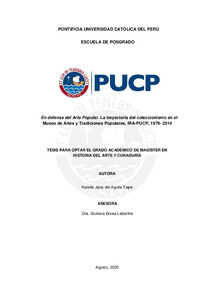| dc.contributor.advisor | Borea Labarthe, Giuliana | |
| dc.contributor.author | Del Aguila Taipe, Natalia Jaira | |
| dc.date.accessioned | 2020-12-17T08:30:07Z | |
| dc.date.available | 2020-12-17T08:30:07Z | |
| dc.date.created | 2020 | |
| dc.date.issued | 2020-12-17 | |
| dc.identifier.uri | http://hdl.handle.net/20.500.12404/17716 | |
| dc.description.abstract | El Museo de Artes Popular (1979), hoy llamado Museo de Artes y Tradiciones Populares
(MATP) surgió de una coyuntura especial: las discusiones académico-artísticas que se
derivaron del reconocimiento a Joaquín López Antay como ganador del Premio Nacional
de Arte en diciembre de 1975. Desde entonces, el Instituto Riva-Agüero (IRA) no solo
defendió las razones de la designación del Premio Nacional, sino también recogió la
postura de una serie de intelectuales que reconocían en el arte popular peruano la
“verdadera” manifestación del desarrollo y sincretismo de la plástica nacional.
El objetivo de este trabajo es comprender la historia y el proceso de formación de un
espacio expositivo como el MATP, un museo universitario y de temática específica (arte
popular), a través del análisis valorativo de la práctica del coleccionismo de arte popular
en el transcurso del siglo XX. Estas prácticas han transitado de la recopilación de objetos,
al viejo estilo etnográfico, a una participación efectiva de los propios artistas. En el caso
del MATP se observa el desarrollo de un tipo específico de práctica basado en el trabajo
colaborativo entre gestor-curador/coleccionista/artista.
Espacios como el MATP han permitido la visibilidad, internacionalización y difusión del
arte popular peruano, brindándoles de cierto modo una presencia y voz a aquellos actores
que estuvieron rezagados en los circuitos artísticos de la capital durante el siglo XX. Así el
Museo cumple una misión planteada desde el IRA que es la participación inclusiva con la
ciudadanía. | es_ES |
| dc.description.abstract | The Museum of Popular Art (1979) of the Pontificia Universidad Catolica del Peru’s Riva-
Agüero Institute (IRA-PUCP), currently known as Museum of Traditions and Popular Art
(MATP) arose from a special context: the academic-artistic debates that resulted from the
recognition of Joaquin Lopez Antay as a winner of Peru’s National Art Prize in December
1975. The IRA not only defended the reasons for the designation of the National Art Prize
but also took a stand with intellectuals who recognized Peruvian popular art as a “truthful”
manifestation of Peru’s art.
The aim of this dissertation is to understand the history and the process of formation of the
university Museum of Traditions and Popular Art by analyzing the collecting practice of
folk art during the 20th century. These practices have moved from the collection of objects,
in an old ethnographic style, to an effective participation of the artists themselves. The
MATP’s case shows us the development of a specific type of practice for the conformation
of Peruvian popular art collections based on collaborative work among promoter- curator/
collector / artist.
Institutions such as the MATP have allowed the visibility, internationalization, and
diffusion of Peruvian folk art, in a way that gives presence and voice to those actors who
were excluded from the Lima’s artistic networks during the 20th century. Thus, the
Museum fulfills a mission, promoted by the IRA, which involves the citizens’ participation. | es_ES |
| dc.description.uri | Tesis | es_ES |
| dc.language.iso | spa | es_ES |
| dc.publisher | Pontificia Universidad Católica del Perú | es_ES |
| dc.rights | info:eu-repo/semantics/openAccess | es_ES |
| dc.rights.uri | http://creativecommons.org/licenses/by-nc-nd/2.5/pe/ | * |
| dc.subject | Pontificia Universidad Católica del Perú. Instituto Riva-Agüero. Museo de Artes y Tradiciones Populares--Historia | es_ES |
| dc.subject | Museos de arte--Perú--Lima | es_ES |
| dc.subject | Arte popular--Perú--Siglo XX | es_ES |
| dc.title | En defensa del Arte Popular. La trayectoria del coleccionismo en el Museo de Artes y Tradiciones Populares, IRA-PUCP, 1979- 2014 | es_ES |
| dc.type | info:eu-repo/semantics/masterThesis | es_ES |
| thesis.degree.name | Maestro en Historia del Arte y Curaduría | es_ES |
| thesis.degree.level | Maestría | es_ES |
| thesis.degree.grantor | Pontificia Universidad Católica del Perú. Escuela de Posgrado | es_ES |
| thesis.degree.discipline | Historia del Arte y Curaduría | es_ES |
| renati.advisor.dni | 10808668 | |
| renati.advisor.orcid | https://orcid.org/0000-0002-0107-4170 | es_ES |
| renati.author.dni | 41356489 | |
| renati.discipline | 222197 | es_ES |
| renati.juror | Vidarte Basurco, Giuliana Elizabeth | |
| renati.juror | Borea Labarthe, Giuliana | |
| renati.juror | Huerta Mercado Tenorio, Victor Alexander | |
| renati.juror | Yllia Miranda, María Eugenia Rocío | |
| renati.level | https://purl.org/pe-repo/renati/level#maestro | es_ES |
| renati.type | http://purl.org/pe-repo/renati/type#tesis | es_ES |
| dc.publisher.country | PE | es_ES |
| dc.subject.ocde | http://purl.org/pe-repo/ocde/ford#6.04.04 | es_ES |






